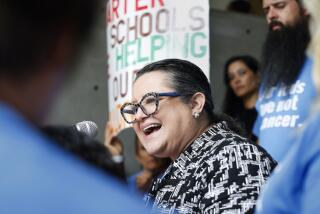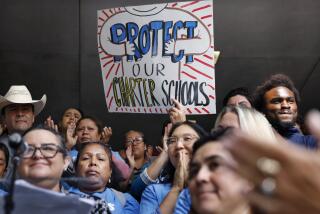For students at L.A.’s Big Picture charter school, downtown is their classroom
During geometry, students at Los Angeles Big Picture High School walk outside to study the intricate building facades in downtown’s financial district. Drama classes stroll to the Ahmanson Theatre to catch a play. For lunch, students often go two blocks to the steps of the stately Central Library.
The school’s home on the third floor of 700 Wilshire Blvd. allows teachers to fuse downtown L.A. with their lessons. “It expands our classroom,” said Principal Nicole Nicodemus. “It opens up a whole new world for our kids.”
The school is part of Big Picture Learning, a Rhode Island-based charter group that operates 43 schools in 17 states and four countries. Charters are independently run and publicly funded.
Educators at Big Picture campuses aim to provide a more individualized curriculum that incorporates the students’ world outside the classroom, according to the group. The L.A. school opened in 2010 and has 86 students in grades nine through 12. Most are Latino and are eligible for free or reduced-priced lunch, apoverty indicator.
Nearly all of the students live in South Los Angeles and take buses or the subway to school each day, many arriving at the nearby 7th Street station. Most live only a few miles away but had never visited downtown — many had never left their neighborhoods, Nicodemus said.
Jessica Davis, an advisor at the school, recalled a quick subway ride to Chinatown with some students. “They asked, ‘What city are we in?’ They’d never heard of Chinatown,” she said. “Now, they’re constantly talking about how worldly and special they feel.”
A classroom can be limiting, Nicodemus said. A lesson in government, for example, can fall flat on students who have never seen politicians in action.
“We can go down to the Metro, go two stops, pop up and go visit City Hall and show them what it looks like instead of only learning about it from a book,” she said.
Students develop projects based on their own interests and forge partnerships with local businesses, nonprofits and others to have an impact in their community
One student with an interest in fashion sought out a boutique owner in Santa Monica and worked with students at the nearby FashionInstitute of Design & Merchandising. Another is developing informational resources for recent immigrants; she sought the help of the Coalition For Humane Immigrant Rights of Los Angeles and made contacts at an immigration rally outside a federal prison downtown.
On a recent afternoon, Brandon Uribe, a junior with an interest in architecture, described his work designing new student study pods at the school. With help from contacts he made during an internship at Steinberg Architects, which has an office a block away, he studied the optimal design specifications and polled students on what they wanted in a study space.
“It would have been way harder if I didn’t already have that connection” to the architects, he said.
The proximity to working professionals — even if it’s only a shared subway ride — helps build students’ confidence.
“There’s a certain mentality that ‘I too will be someone’ – which is essential,” Nicodemus said.
Jose Cole-Gutierrez, the L.A. Unified School District’s charter school division director, said the school’s model of student-led projects is unique to Los Angeles.
The district authorizes charters within its boundaries, but under state law these schools have broad autonomy in areas such as spending, staffing and curriculum.
Big Picture, Cole-Gutierrez said, has struggled academically in recent years, with sagging results as measured on the Academic Performance Index — used to judge schools’ performance in the state.
“They’ve had some success and some challenges academically,” he said. “The enrollment has been low the last few years. That would obviously impact any program.”
Nicodemus contends that student achievement can’t always be captured by results on a state exam. Students at Big Picture study and learn the same material as other schools, but also graduate with an understanding of how to interact and learn in the world outside of school.
New standardized tests, based on Common Core learning goals adopted across the country, favor critical thinking skills and are designed to better measure how much students are learning.
“The type of educational program we are providing students are getting them to think on that level,” Nicodemus said. “I think we’ll be able to demonstrate that on the new tests.”
Kari Morrison, a 16-year-old junior, started Big Picture in the fall. She’s been homeless but is now staying with relatives and friends throughout the city. She had struggled to stay engaged in her studies at Manual Arts High School, so when her mom noticed a Big Picture brochure at a library, they thought they’d try it.
Kari said she received personalized attention from teachers in the subjects she previously struggled to understand. To her surprise, teachers asked what her interests were and what she would like to study.
“I thought ‘Why not homelessness?’” she said. She linked up with a Hollywood homeless shelter, studied the causes of homelessness and created a clothing drive. She’s figured out that she’d like to go to college and create organizations to help others.
“I’ve come so far,” Kari said. “It gives me hope.”
That’s appropriate, she joked, because the school’s on the corner of Wilshire and Hope Street.
Twitter: @sjceasar
More to Read
Start your day right
Sign up for Essential California for news, features and recommendations from the L.A. Times and beyond in your inbox six days a week.
You may occasionally receive promotional content from the Los Angeles Times.







